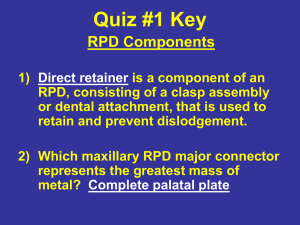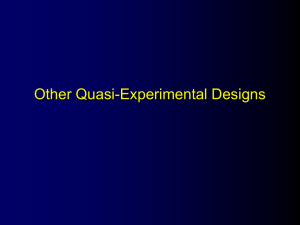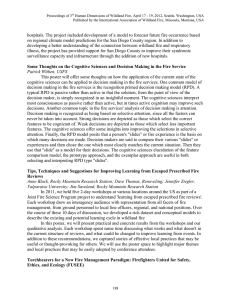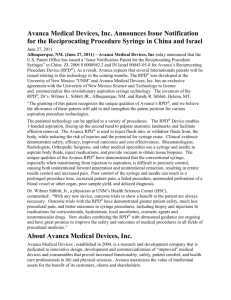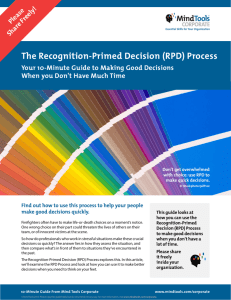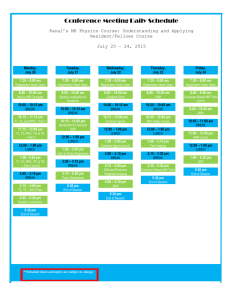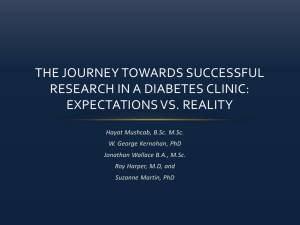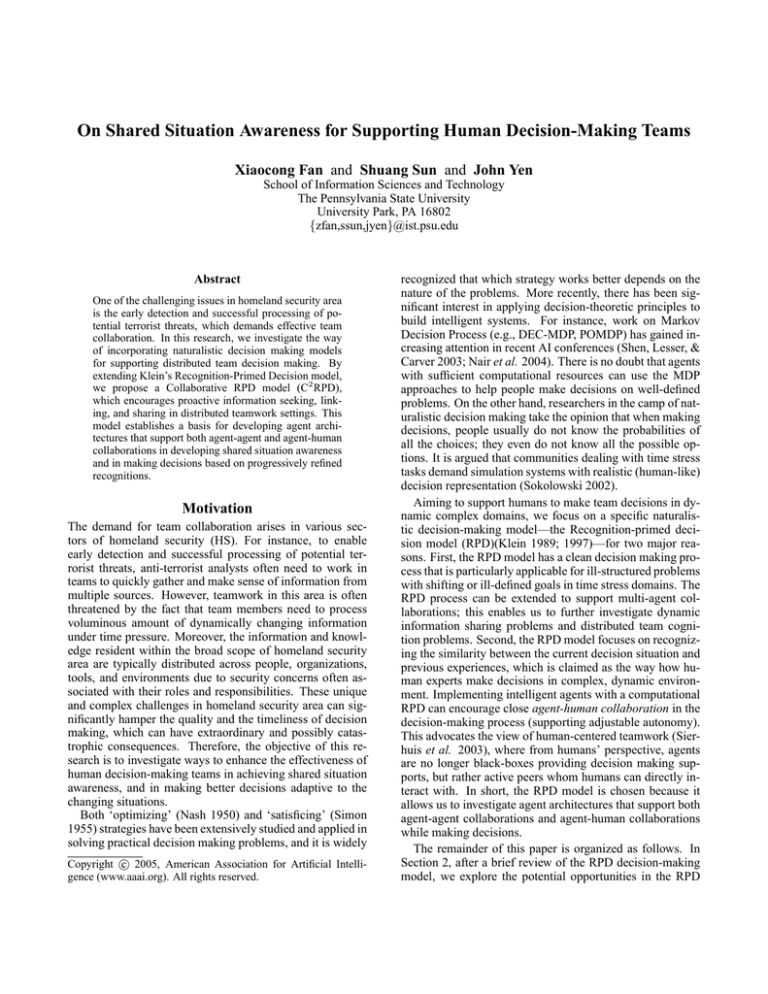
On Shared Situation Awareness for Supporting Human Decision-Making Teams
Xiaocong Fan and Shuang Sun and John Yen
School of Information Sciences and Technology
The Pennsylvania State University
University Park, PA 16802
{zfan,ssun,jyen}@ist.psu.edu
Abstract
One of the challenging issues in homeland security area
is the early detection and successful processing of potential terrorist threats, which demands effective team
collaboration. In this research, we investigate the way
of incorporating naturalistic decision making models
for supporting distributed team decision making. By
extending Klein’s Recognition-Primed Decision model,
we propose a Collaborative RPD model (C2 RPD),
which encourages proactive information seeking, linking, and sharing in distributed teamwork settings. This
model establishes a basis for developing agent architectures that support both agent-agent and agent-human
collaborations in developing shared situation awareness
and in making decisions based on progressively refined
recognitions.
Motivation
The demand for team collaboration arises in various sectors of homeland security (HS). For instance, to enable
early detection and successful processing of potential terrorist threats, anti-terrorist analysts often need to work in
teams to quickly gather and make sense of information from
multiple sources. However, teamwork in this area is often
threatened by the fact that team members need to process
voluminous amount of dynamically changing information
under time pressure. Moreover, the information and knowledge resident within the broad scope of homeland security
area are typically distributed across people, organizations,
tools, and environments due to security concerns often associated with their roles and responsibilities. These unique
and complex challenges in homeland security area can significantly hamper the quality and the timeliness of decision
making, which can have extraordinary and possibly catastrophic consequences. Therefore, the objective of this research is to investigate ways to enhance the effectiveness of
human decision-making teams in achieving shared situation
awareness, and in making better decisions adaptive to the
changing situations.
Both ‘optimizing’ (Nash 1950) and ‘satisficing’ (Simon
1955) strategies have been extensively studied and applied in
solving practical decision making problems, and it is widely
c 2005, American Association for Artificial IntelliCopyright °
gence (www.aaai.org). All rights reserved.
recognized that which strategy works better depends on the
nature of the problems. More recently, there has been significant interest in applying decision-theoretic principles to
build intelligent systems. For instance, work on Markov
Decision Process (e.g., DEC-MDP, POMDP) has gained increasing attention in recent AI conferences (Shen, Lesser, &
Carver 2003; Nair et al. 2004). There is no doubt that agents
with sufficient computational resources can use the MDP
approaches to help people make decisions on well-defined
problems. On the other hand, researchers in the camp of naturalistic decision making take the opinion that when making
decisions, people usually do not know the probabilities of
all the choices; they even do not know all the possible options. It is argued that communities dealing with time stress
tasks demand simulation systems with realistic (human-like)
decision representation (Sokolowski 2002).
Aiming to support humans to make team decisions in dynamic complex domains, we focus on a specific naturalistic decision-making model—the Recognition-primed decision model (RPD)(Klein 1989; 1997)—for two major reasons. First, the RPD model has a clean decision making process that is particularly applicable for ill-structured problems
with shifting or ill-defined goals in time stress domains. The
RPD process can be extended to support multi-agent collaborations; this enables us to further investigate dynamic
information sharing problems and distributed team cognition problems. Second, the RPD model focuses on recognizing the similarity between the current decision situation and
previous experiences, which is claimed as the way how human experts make decisions in complex, dynamic environment. Implementing intelligent agents with a computational
RPD can encourage close agent-human collaboration in the
decision-making process (supporting adjustable autonomy).
This advocates the view of human-centered teamwork (Sierhuis et al. 2003), where from humans’ perspective, agents
are no longer black-boxes providing decision making supports, but rather active peers whom humans can directly interact with. In short, the RPD model is chosen because it
allows us to investigate agent architectures that support both
agent-agent collaborations and agent-human collaborations
while making decisions.
The remainder of this paper is organized as follows. In
Section 2, after a brief review of the RPD decision-making
model, we explore the potential opportunities in the RPD
process where team collaboration can be naturally introduced. In Section 3, we describe a collaborative RPD
model–C2 RPD, focusing on how distributed agents work together to develop shared situation awareness, to collaboratively build stories through hypothesis exploration and experience synthesization, and to support adaptive decision making through expectancy monitoring. Section 4 explains how
a human partner may collaborate with an RPD-agent in the
RPD process, and Section 5 summarizes the paper.
Experience the situation in a Changing Context
more
data
Diagnose
[Feature Matching]
[Story Building]
revise
Is situation
Typical?
No
inference
yes
Clarify
Recognition has 4 byproducts
RPD And Collaboration Opportunities
In this section, after a brief review of Klein’s RPD model, we
argue for an RPD-based collaborative approach, and examine where agent-agent collaborations and human-agent collaborations can be incorporated into the RPD process.
Plausible
Goals
The RPD Model
The RPD model (Klein 1989) (see Figure 1) captures how
domain experts make decisions based on the recognition
of similarity between the current situation and past experiences. RPD has two phases: recognition and evaluation. In
recognition phase, a decision maker needs to develop situation awareness and recognize what course of actions worked
before in similar situations. In evaluation phase, a decision
maker needs to carry out ‘singular evaluation’ by imaging
how a course of actions will evolve. In case that a course of
actions does not work for the current situation, the decision
maker can either adjust the course of actions, or find and
examine another one until a workable solution is obtained.
The RPD model states that ‘feature-matching’ and ‘storybuilding’ are two typical strategies used by experts to develop situation awareness. In feature-matching, a decision
maker tries to find whether he/she has ever experienced situations similar to the current one by matching the set of
observed cues (synthesized from information describing the
current situation) with the pattern of cues considered in past
experiences. In case that feature-matching cannot produce
an adequate account for the current situation due to lack of
experience, story-building will be used to construct an explanation, with the collection of observed information being coherently linked. A story gives an explanation of how
the current situation might have been emerging. In storybuilding, a decision maker can explore potential hypotheses
in his/her mind and evaluate how well each of them may fit
the observed events.
The recognition phase has four products: relevant cues
(what to pay attention to), plausible goals (which goals make
sense), expectancy (what will happen next), and course of
actions (what actions worked in this type of situation). An
expectancy serves as a gate-condition for continuing working on the current recognition. Due to the dynamic and
uncertain nature of the environment, it is very important to
monitor the status of expectancy because a decision maker
may have misinterpreted the current situation but he/she cannot recognize it until some expectancy is invalidated as the
situation further evolves. In such cases, the decision maker
needs to further diagnose the current situation (e.g., to gather
more information).
Relevant
Cues
Expectancies
Anomaly
Action 1-
n
other
option
Evaluate Action i
[Mental Simulation]
Modify
yes, but
works?
No
yes
Implement
Course of Action
Figure 1: The RPD Model
Collaboration Opportunities
The RPD model captures the cognitive activity undergoing
in the mind of a decision maker when he/she faces a decision task. In essence, RPD is an individual process because it is within a decision maker’s mental state. However,
it becomes more interesting when a team of human experts,
each making decisions using RPD, needs to work together
in distributed dynamic environments. Intuitively, team performance can be considerably enhanced if the team can establish a shared mental model about the dynamic progress
of the RPD process being pursued by the decision maker.
Emphasizing the individual nature of the RPD process may
weaken or ignore the active roles played by the other teammates in the process, expecially from the information seeking and sharing perspective.
On the other hand, as domain complexity increases, decision making often involves various kinds of expertise and
experiences, which are typically distributed among a group
of decision makers (Hollenbeck et al. 1997). In such cases,
the timeliness and quality of decision making highly depend
on the effectiveness of team wide collaboration (e.g., anticipating others’ information needs, proactive sharing information and expertise).
Thus, in our study, we consider the situations where a
group of people who are experts in different areas, each assisted by one RPD-enabled agent (i.e., agents capable of
making decisions using RPD model), face the pressure to
make better and faster decisions in an environment with high
domain complexities. In such a setting, collaboration may
exhibit among RPD-agents, between an RPD-agent and its
human partner, and among the human experts. Here, we focus on agent-agent and human-agent collaborations.
A careful scrutiny of the RPD model under teamwork settings reveals that potential agent-agent collaboration opportunities include:
• Situation Awareness: Each agent may only know (or be
sensitive to) certain kinds of information. To develop a
complete view of the global state, team members need to
share their information;
• Feature Matching: In feature matching, an agent can monitor the information needs of the decision making agent,
and proactively deliver relevant information;
• Story Building: When building a story, the agents can
collaboratively explore potential hypotheses and progressively anticipate other’ information needs;
• Expectancy Monitoring: All the agents keep an eye on the
active expectancies and report anomalies to others whenever applicable.
Potential agent-human collaborations include:
• Situation Awareness: An agent shows its human partner
the cue patterns being considered. The human partner can
suggest the agent to consider new cues for the current decision situation;
• Feature Matching: An agent can show its human partner
the result of feature-matching, e.g., the degree of similarity between each of the matched experience and the current situation. The human partner can adjust the matching strategies (e.g., thresholds), provide information that
is still missing, suggest expectancies to be considered, adjust the pressure (the stress level of the current decision
situation);
• Story Building: A human partner can suggest the agent
to explore a specific hypothesis, help the agent to link the
available information together. The agent can show its
human partner the supporting or negative evidences regarding the explored hypotheses, show the stories being
built, etc;
• Expectancy Monitoring: A human partner can input insights on how to handle the exceptions resulted from expectancy anomalies. The agent can show its human partner the potential side-effects caused by an expectancy
anomaly.
Collaborative RPD Model
In this section, we describe C2 RPD—a computational collaborative RPD model (as illustrated in Figure 2), which captures both agent-agent collaborations and agent-human collaborations. We mainly focus on how agents take the aforementioned opportunities to support iterative recognition and
adaptive decision makings.
Types of Decision-Making Tasks
Making decisions on what to do next is a task at an abstract
level above domain tasks. Each decision-making task has
certain knowledge (expertise) requirements on the decision
maker. Two decision-making tasks belong to the same type
if they place the same knowledge requirements. For example, Hollenbeck et al. (1997) described a scenario involving
a four-person naval command and control team. The team
needs to monitor the airspace in the vicinity of an aircraft
carrier battle group, and to decide how to respond to the incoming air targets. This type of decision making requires
two forms of expertise: (a) the ability to measure and translate raw attributes (e.g., speed, altitude, angle, IFF, etc) of an
aircraft into internal opinions (cues) regarding how threatening the aircraft is, and (b) the rules specifying how to combine cue values to determine the level of threat.
In addition, decision making in human society is typically
connected with societal hierarchies; a higher-level decisionmaking task usually depends on the results of lower-level
decision-making tasks. In order to support multiple-level decision makings (Hollenbeck et al. 1995), in our model, we
use the concept of “decision spaces” to organize experiences
hierarchically according to decision types: experiences related to one decision type are maintained in one decision
space or experience knowledge base (EKB).
Treated as such, decision making and information fusion
can be tightly coupled at multiple levels, if we view the process of decision making as a process of fusing input information into decision results. This is also flexible for supporting
teams where knowledge and expertise are distributed among
team members. For instance, members of an anti-terrorist
analyst team may have different access to various information sources due to security concerns or due to their roles
and responsibility in the team. The team members can make
decisions at different levels relative to their past experiences.
What is also important is that an agent can be involved
in multiple decision tasks, which may or may not have relations. It is thus necessary for an RPD-agent to be able
to effectively manage multiple attentions (RPD processes).
For the flexibility of the C2 RPD model, we leave the issue
of attention management open to the designers of agent architectures.
Now we come to the experience representation. Each experience has four parts: cues, goals, course of actions, and
expectancies. An experience can be formally denoted as
ei = hCi , Gi , Ei , Ai i, where Ci , Gi , and Ei are collections
of predicates, and Ai is a set of plan names, referring to predefined courses of actions. Let the collectionSof cues consider by a decision space EKB be CEKB = ei ∈EBK Ci .
In our model, no restriction is placed on the sources of
decision tasks 1 . Responding to a decision task t, an RPDagent will first follow the procedure below to initialize the
RPD process:
1. From the current situation, determine the collection Ft of
features that are potentially relevant to the task;
2. Explore the decision space hierarchy to pick one that is
applicable to the decision task. A decision space EKBj
is chosen and fixed in the rest of the RPD process if Ft can
1
It could be a pre-specified step in a plan, could be a request
from a human partner or other teammates, or could be dynamically
identified by an agent itself.
RPD -Agent
Other RPD -Agent
Human DM
planned decision points
recognized decision needs
decision requests
inform decision task
Decision Task
Analysis
Commit to
Decision Task
Decision Task
Review
Have time to
refine
recognition?
Situation
Familar ?
no
yes
Interrupt RPD -agent
Provide COA
no
yes
Process incoming
information
Match cues
with features
information
link analysis
request missing
information
request missing
information
Get the most
matched
experiences
Get the most
reasonable
stories
feature matching
story building
Inform
Recognition Results
Monitor
Expectancy
recognition
ready?
yes
adjust
recognition?
adjust time constraints
adjust recognition
strategy
adjust cue weight
input human assessment
review missing
information
provide if
available
Evaluate
COA
COA
Adjust COA
Implement
yes
anticipated
Info Needs?
yes
yes
collect missing
information
proactive
inform
provide if
available
Monitor
Expectancy
Evaluate
Anomaly?
COA
Adjust COA
Adjust COA
yes
yes
Inform
exceptions
Inform
exceptions
no
Learning
recognition
ready?
no
Anomaly?
Evaluate
Being
requested?
yes
yes
Monitor
Expectancy
yes
Anomaly?
Being
requested?
Learning
Implement
COA
COA
Figure 2: The C2 RPD Model
be covered by CEKBj . However, the determination of Ft
itself is a high-demanding cognitive task, and the selected
decision space might not be the desired one. Thus, an
internal mechanism of decision-space adaptation is highly
needed so that the RPD-agent can recover from wrong
selections of the decision space.
3. If there is no decision space applicable to t, i.e., the RPDagent cannot handle the task due to lack of expertise, this
agent has to find one competent RPD-agent and transfer
the task to that agent.
4. The agent whoever makes an commitment to a decision
task will then let others know so that the others can help
in the rest of the decision making process. Those agents
who also have the required decision-making knowledge
(they thus know what is needed in making that decision)
can proactively help on task t and lower-level decision
tasks, if any. Although those agents who do not have the
required knowledge cannot easily anticipate the decision
maker’s needs, they can also provide help if they receive
information requests for developing situation awareness.
Now we look at the organization of experiences within a
decision space. We can formally define a refinement relation
(v) among experiences (recognitions). For any experiences
ei = hCi , Gi , Ei , Ai i and ej = hCj , Gj , Ej , Aj i in a decision space, ei v ej iff Ci ⊆ Cj . This is a rather weaker
requirement: an experience is a refinement of another if it
considered more information (cues) in the recognition. A
stronger refinement relation can be defined in terms of addi-
EKBi
e10
e0
e1
e4
e2
e5
e6
e23
e21
e3
e7
e34
e32
e15
e26
Figure 3: The structure of a decision space
tional relations between the other components. For instance,
for some types of decisions, it may make sense to define:
ei v0 ej iff Ci ⊆ Cj , Gi = Gi+1 , and Ai ≺ Ai+1 , where
≺ is sequence prefix relation: an experience is a refinement
of another if it considered more information (cues) in the
recognition, both share the same goals, and the course of
actions associated with ei is simply the prefix of what is associated with ej . From such a perspective, experiences in an
EKB can be virtually viewed as being partitioned by some
experience refinement relations. For the example illustrated
in Figure 3, after experience e10 being considered, experience e23 (where both e10 v e23 and e32 v e23 hold) may
be selected in the next round of recognition as more information becomes available. However, to elicit a meaningful experience-refinement relation from a decision space is
domain-dependent, and the detailed discussion of it is out of
the scope of this paper.
Collaborative Situation Awareness
The term feature is used to refer to those environmental variables that describe elementary physical or mental parameters (e.g., velocity, moving direction, etc.) (Sokolowski
2003). These environmental variables together characterize
the decision situation, and circumscribe the range of information to which the decision-making team should pay attention. Each team member may have limited sensing capabilities (e.g., types of sensors, sensing ranges) regarding the
environmental variables, therefore the whole team has to exchange information in order to develop a shared awareness
of the global situation. We assume each agent use an individual knowledge base (KB) to maintain all the information
(acquired either from the environment or from other agents)
regarding the current situation.
The term “cue” refers to an agent’s internal representation
of the decision situation. Cues are higher-level abstractions
of the elementary data or synthesization of lower-level information. For example, internally an agent may only care
the fuzzy category (e.g., high, medium, low) rather than the
real value of an object’s velocity; the “moving pattern” of an
approaching unit can be synthesized (fused) from the information regarding the moving directions of all the individuals
in the unit. Generally, a cue can be the root of several treelike information-dependence structures, which describe the
ways how the cue is abstracted from low-level information.
We use {τ (A)ic } to denote the collection of informationdependence trees with cue c as the root, relative to agent A’s
expertise; use T (A)0c to denote the instantiation of τ (A)0c ,
where marked are the nodes of which the agent A is lacking
information, relative to A’s KB.
Situation Awareness Driven By Relevant Cue Analysis An agent can derive information requirements regarding
the current decision task from the cues under its consideration. The following process can be used to collect missing
information:
Procedure Investigate(task, Team)
1. if (self is the decision maker for task)
2. EKB = getDecisionSpace(task);
3. Cues = getRelevantCues(EKB);
4. Repeat
5.
{hck , T (self )ck i} = getCuesUnknown(Cues);
6.
for each hck , T (self )ck i
7.
Peers = getProviders(hck , T (self )ck i);
8.
Ask(Peers, hck , T (self )ck i);
9.
if (hcn , T (sender)cn i received)
10.
SynthesizeInfo(self.KB,hcn , T (sender)cn i);
11.
Learning(hcn , T (sender)cn i);
12. Until (Terminated)
13. else
14. if (self has expertise for task)
15.
EKB’ = getDecisionSpace(task);
16.
Cues’ = getRelevantCues(EKB’);
17.
Repeat
18.
{hcj , T (self )cj i} = getCuesAvailable(Cues’);
19.
Tell(task.decisionMaker(), {hcj , T (self )cj i});
20.
Until (Terminated)
21. else
22.
Repeat
23.
if (Being asked of hck , T (sender)ck i)
24.
m = getAvailableInfo(hck , T (sender)ck i);
25.
Reply(sender, m);
26.
Until (Terminated)
Figure 4: The algorithm for shared awareness
As is encoded in the algorithm in Figure 4, agents in a
team may play different roles when investigating a situation.
• The decision maker agent (DM), while trying to synthesize the available information into appropriate cues, may
not be able to attain a sufficient level of situation awareness due to lack of critical information. For every unknown cue, the DM can ask for help from some potential information providers. Upon receiving information
from teammates, as well as synthesize the new acquired
information to develop better situation awareness, the DM
could also learn new information-dependence trees from
teammates, and revise experiences in its EKB to incorporate additional cues being considered by other agents.
• Teammates who have the experiences pertinent to the current task can proactively tell the decision maker (DM)
about the information relevant to the cues that need to
be considered. Since an agent and the DM agent may
have different EKBs and information-dependence structures, the teammate can (1) inform the DM agent about
Collaborative Story Building
While feature matching is used to find past experiences that
most match the current situation, story building is used when
agents are experiencing unfamiliar situations. From another
perspective, feature matching is to build a story for the current situation using ‘templates’ worked before, while story
building is to construct a story from scratch.
Story building also involves information gathering, but it
is more than cue-driven information investigation (Fig.4),
because the agents are still unclear about what cues to investigate. Therefore, the key is to identify a collection of cues
which the team needs to pay attention to. C2 RPD adopts
a combination of two mechanisms: hypothesis exploration
and experience synthesization.
A hypothesis could be an abstract story (e.g., there is a
chance that City Y is facing some terroristic attack within
2 weeks), or a plausible intention (e.g., the object moving
toward Building Z is probably hostile). To support collaborative hypothesis exploration, we employ the idea of multiparty conversation (Dignum & Vreeswijk 2004), where all
Generate goals, cues,
expectancy, and COA
Context 4
X must/not be Y
Is i
acceptable?
Context 3
Things should/not happen soon
explore
hypothesis i
Given that hypothesis is true
Context 1
Things should/not have happened
It is worth noting that the information exchanged among
RPD-agents is of form hcue, dependence-structurei. This
has two benefits. First, in doing so, the agents are not
only requesting/sending information relevant to the cue, they
also explicitly requesting/sending information that is indirectly related to the cue according to the accompanying
dependence-structure. In essence, the dependence-structure
establishes an information use context; an agent can help the
information needer with all the information matched with
the nodes of the dependence-structure that are marked as
‘unknown’ by the needer. Second, an agent may respond
to an information request using a dependence structure different from the one being used by the requesting agent. Accordingly, the agents in a team can exchange and learn expertise about information-dependence structures from each
other. This can progressively enable the agents to better anticipate others’ information needs.
The investigation process is the key to evolving recognitions. It is an anytime algorithm; the decision making agent
can trigger the feature-matching function at any point of the
investigation process, as long as the agent has attained a satisfactory level of awareness of the current situation. Since
the information regarding the current situation is recorded
in the DM agent’s KB, the feature matching process simply iterates over the experiences in the active EKB and casts
queries to the DM agent’s KB with the cues to be evaluated.
The experiences with the most number of cues satisfied wrt.
the DM agent’s KB are returned as the recognition results.
explore another
• Teammates who have no experience for the current task
can help the DM agent upon being requested of certain information. Here, an teammate could reply the DM agent
with information that is synthesized in a way different
from the structure being considered by the DM agent.
Potential
Hypotheses
Context 2
Things should/not be doing
the cues that have been synthesized in ways beyond the
DM’s existing expertise, (2) share experiences by informing the cues that are considered in its EKB, but may not
in the DM agent’s.
multi-context multi-party conversation
Figure 5: Hypothesis exploration in story building
the agents can hear the messages exchanged in a team, even
though some are not necessarily the intended audiences. For
instance, agent B can comment on agent C’s messages directed to agent A. Figure 5 illustrates the process of hypothesis exploration. First, the decision maker agent (DM) can
initiate a conversation to collect potential hypotheses that the
team needs to further investigate. The team can use different strategies (e.g., agreed by most, proposed by a creditable
agent, suggested by human partners, etc.) to determine the
hypotheses that reflect the current situation best. To explore
a hypothesis h, the team members are involved in conversations under four contexts: (1) given that h is true, each
agent, based on its expertise, infers what things should/not
have happened, and proclaim to others for confirmation. A
thing that should have happened but actually not, or the other
way around, shows a negative evidence to h; (2) given that
h is true, each agent infers what things should/not be doing
now, and proclaim to others for confirmation. A thing that
should be doing but actually not, or the other way around,
shows a negative evidence to h; (3) given that h is true, each
agent infers what things should/not happen later, and proclaim to others for validation. A thing that should happen
within a minute but actually not as expected, or the other
way around, shows a negative evidence to h; (4) given that
h is true, each agent draws reasonable conclusions of form
“X must/not be Y” (e.g., the unidentified object must be a
neutral force; City P must have an airport) and proclaim to
others for verification. In case that X must be Y but actually not, or the other way around, shows a negative evidence
to h. Note that all the above four kinds of claims could be
associated with a value that indicates the claiming agent’s
confidence degree.
To evaluate a hypothesis, the DM agent needs to consider
both the positive and negative evidences collected in the
multi-party conversation, and to reconcile conflicting conclusions drawn by different team members, if any. Certain
human-adjustable thresholds can be used to judge whether
the hypothesis applicable to the current situation. If not, the
agents continue to explore another hypothesis until find an
acceptable one. If yes, the DM agent can then generate a
pseudo-experience in the following way: (1) use the proven
hypothesis to produce goals, the fulfillment of which could
prevent the situation from evolving toward undesired direction (e.g., to invalidate a hostile attempt, to protect a vulnerable place); (2) use the information gathered in context
1, 2, and 4 to produce cues; (3) use the information gathered in context 3 and 4 to produce expectancies; and (4) use
the information gathered in context 2 and 3 to construct a
course of actions (COA). Once it is proved that the COA
works, the pseudo-experience will be stored as a valid experience for dealing with ensuing similar situations. Agents
can also learn from unworkable pseudo-experiences so that
they would not make the same mistakes when similar situations occur.
Experience synthesization is used when two or more past
experiences can be combined together to deal with an unusual situation. Synthesization could be based on experiences from single or multiple agents, and the four components of a synthesized experience are typically the coupling
of the corresponding parts of the input experiences. From
another perspective, novel situations offer opportunities for
agents to share and reflect on their experiences.
Collaborative Expectancy Monitoring
After an RPD-agent makes a recognition, it will continuously monitor the associated expectancies until the completion of the selected course of actions. Expectancy monitoring is one of the key features to support adaptive decision
makings (Serfaty, Entin, & Johnston 1998). A DM agent
can subscribe information relevant to the expectancies that
need to be continuously monitored. Such collaborative expectancy monitoring can take full advantage of the team’s
distributed cognition, so that the DM agent can terminate
the actions resulted from a wrong recognition at the earliest
opportunity.
First, expectancies can be used to initiate a complete new
decision. An expectancy states what will happen, serving as
a gate-condition for keeping following the current recognition. Some expectancies may be so crucial that whenever
they conflict with the new observed facts, it indicates the
decision maker has heavily misinterpreted the current situation. In such cases, the RPD-agent has to diagnose the
current recognition, re-considering the whole space of the
active EKB for another time.
Second, RPD-agents can use expectancies to refine a decision, leveraging some structures within the active EKB. The
invalidation of some expectancies may indicate that the once
workable recognition is no longer applicable to the changing
situation. The already executed part of the selected course of
actions may still make sense, but the rest part has to be adjusted. In such cases, the RPD-agent can start another round
of recognition, using the experience refinement relation described earlier to develop a better solution.
Therefore, the computational C2 RPD model is an iterative
model. It explicitly incorporates the idea of “recognition refinement”, and supports situation reconsideration during action execution phase. In addition, the computational model
is much flexible for studying the time pressure issue in decision making. Since RPD-agent can make a sequence of decisions (the length of the sequence is restricted by the exter-
nal time pressure), with one decision refining the preceding
ones, it can always return an acceptable decision relative to
the timing constraints. This guarantees no critical decision
is missed under stress situations.
Human-Agent Collaboration
As shown in Figure 2, a human may collaborate with his/her
partner agent in various ways along the RPD process. On
the one hand, as an assistant to its human decision maker,
an agent needs to help the human partner develop situation
awareness, considering the limitation of human’s cognitive
capacity; needs to help the human understand the progress
of its internal RPD process (e.g., displaying the progress in
a user-friendly flow chart); needs to request heuristic information from the human without imposing too much interruption; needs to recommend workable solutions to the human, clarifying what’s the impact to other teammates if one
option is chosen.
On the other hand, RPD-agents, leveraging humans’
meta-level reasoning, are reflective and self-adaptable. First,
a human can direct the process of recognition refinement
by suggesting/revising the experience refinement relations
in the current decision space. Agents can thus take humans’ meta-cognition into consideration in the next round
of recognition. This can also stepwisely help people elicit
the tacit expertise that may reside solely in their minds, and
transform it into explicit knowledge that can be effectively
used by agents in later decision situations.
Second, a human can guide an RPD-agent in its information gathering and sharing by suggesting new or revising the
existing information dependence structures. The new or revised dependence structures, which reflect the human’s dynamic adaptation, will largely affect the patterns of information exchange among team members.
Third, human’s input is critical for effective story building. (a) An RPD-agent’s exploration strategy is governed by
its human partner. A human can initiate, suspend, or terminate the exploration of a specific hypothesis, considering all
the supporting and negative evidences so far collected by the
RPD-agent. (b) In order to orchestrate the information from
distributed sources into a coherent form, the key is to discover the tacit information linkages, which can be gracefully
handled by human. The information linkages suggested by
human can be further generalized to create new, or incorporate into the existing, information dependence structures. (c)
To finalize the story being built, an RPD-agent has to ask its
human partner for approval regarding the four components
of the pseudo-experience. Once a proven pseudo-experience
is appended into an RPD-agent’s experience KB, human’s
insights have actually been encoded as reusable knowledge
for handling similar situations in the future.
Fourth, human can also help in monitoring the development of certain expectancies, in adjusting the expectancies
that are no longer applicable, in proposing crucial expectancies that have been neglected before, and in suggesting ways
to handle exceptions accompanied by the violation of an expectancy. An RPD-agent can benefit from such human-agent
interactions in two ways. (a) Based on human’s input during
expectancy monitoring, the experience (say, ei ) selected for
handling the current situation can be evolved into a better
format (e0i ). Alternatively, the agent can alter the structure
of the active decision space by creating a new experience
ei+1 that refines ei . (b) An agent can learn from human’s
response to exceptions, and incrementally gain experiences
for handling similar exceptions.
Fifth, the recognition phase may result in several solutions (COAs). To find a workable COA, the DM agent needs
to consider multiple factors such as potential resource conflicts, timing conflicts, and side effects upon failure. In such
a case, human’s intuition about the priorities of the factors
can facilitate the agent to make a better and faster selection.
Summary
There has been much theory and research presented that investigates team cognition, naturalistic decision making, and
collaborative technology as it relates to real world, complex domains of practice. However, there has been very
little work in combining intelligent agent technology and
naturalistic decision-making models to support distributed
team decision making. In this paper, we described the
collaborative RPD model (C2 RPD), which extends Klein’s
Recognition-Primed Decision model, leveraging both agentagent collaborations and agent-human collaborations during
the decision-making process. This model encourages proactive information seeking and sharing in distributed teamwork settings, thus can be incorporated into cognitive agent
architectures to support distributed team cognition and decision making. R-CAST (Yen et al. 2004), which extends the
CAST agent architecture (Yen et al. 2001), is one system
that has realized the C2 RPD model.
C2 RPD is an abstract model that naturally combines naturalistic decision making with computational intelligence. It
can be used to develop agent systems for enhancing the capabilities of anti-terrorist analysts in early detection of potential terrorist threats. C2 RPD supports adjustable autonomy: agents, together with human partners, can collaboratively monitor expectancies and progressively refine recognitions. C2 RPD is also a self-evolving model, encouraging
the learning of novel experiences and strategies for handling
exceptions from human partners.
Acknowledgement
This research has been supported by AFOSR MURI grant
No. F49620-00-1-0326.
References
Dignum, F., and Vreeswijk, G. 2004. Towards a testbed
for multi-party dialogues. In Dignum, F., ed., LNCS-2922:
Workshop on Agent Communication Languages, 212–230.
Hollenbeck, J. R.; Ilgen, D. R.; Sego, D. J.; Hedlund,
J.; Major, D. A.; and Phillips, J. 1995. Multilevel theory of team decision making: Decision performance in
teams incorporating distributed expertise. J. Appl. Psychol.
80(2):292–316.
Hollenbeck, J. R.; Major, D. A.; Sego, D. J.; Hedlund, J.;
Ilgen, D. R.; and Phillips, J. 1997. Team decision-making
accuracy under difficult conditions: construct validation of
potential manipulations using the TIDE2 simulation. In
Brannick, M. T.; Salas, E.; and Prince, C., eds., Team performancs assessment and measurement. 111–136.
Klein, G. A. 1989. Recognition-primed decisions. Advances in man-machine systems research (Ed: W. B. Rouse)
5:47–92.
Klein, G. A. 1997. The recognition-primed decision (RPD)
model: Looking back, looking forward. Naturalistic decision making (Eds: C. E. Zsambok and G. Klein) 285–292.
Nair, R.; Roth, M.; Yokoo, M.; and Tambe, M. 2004.
Communication for Improving Policy Computation in Distributed POMDPs. In Proceedings of The Third International Joint Conference on Autonomous Agents and Multiagent Systems, 1098–1105. ACM Press.
Nash, J. F. 1950. The bargaining problem. Econometrica
18(2):155–162.
Serfaty, D.; Entin, E.; and Johnston, J. 1998. Team coordination training. In Cannon-Bowers, J., and Salas, E., eds.,
Making decisions under stress: implications for training
and simulation. APA Press. 221–245.
Shen, J.; Lesser, V.; and Carver, N. 2003. Minimizing
Communication Cost in a Distributed Bayesian Network
using a Decentralized MDP. In Proceedings of Second International Joint Conference on Autonomous Agents and
MultiAgent Systems (AAMAS 2003), 678–685. Melbourne,
AUS: ACM Press.
Sierhuis, M.; Bradshaw, J. M.; Acquisti, A.; van Hoof, R.;
Jeffers, R.; and Uszok, A. 2003. Human-agent teamwork
and adjustable autonomy in practice. In 7th International
Symposium on Artificial Intelligence (I-SAIRAS).
Simon, H. 1955. A behavioral model of rational choice.
Quarterly Journal of Economics 69:99–118.
Sokolowski, J. 2002. Can a composite agent be used to implement a recognition-primed decision model. In Proceedings of the Eleventh Conference on Computer Generated
Forces and Beharioral Representation, 431–436.
Sokolowski, J. 2003. Representing knowledge and experience in RPDAgent. In Proceedings of the Twelfth Conference on Behavior Representation in Modeling and Simulation, 419–422.
Yen, J.; Yin, J.; Ioerger, T.; Miller, M.; Xu, D.; and Volz,
R. 2001. CAST: Collaborative agents for simulating teamworks. In Proceedings of IJCAI’2001, 1135–1142.
Yen, J.; Fan, X.; Sun, S.; McNeese, M.; and Hall, D. 2004.
Supporting anti-terrorist analyst teams using agents with
shared RPD process. In IEEE International Conference
on Computational Intelligence for Homeland Security and
Personal Safety, 53–60.

